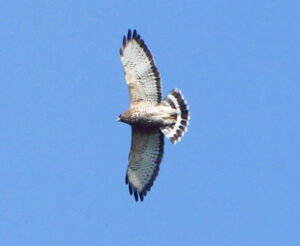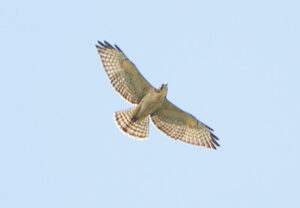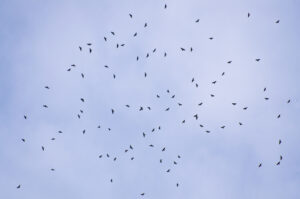Broad-winged Hawk, Buteo platypterus
Bill Rowe
One of the major spectacles that birders can watch for, or even travel to see, is the migration of the Broad-winged Hawk. This small buteo is a summertime inhabitant of mature forests across much of southern Canada and the eastern United States, moderately common but not always so easy to find and study in its leafy woodlands. In fall, however, they suddenly become conspicuous, migrating en masse along hills and ridges and across bodies of water, gathering in flocks as they take advantage of warm air pockets that buoy them up and speed them on their way. These flocks, called “kettles,” will often number in the dozens or even hundreds of birds as they wheel around, then peel off and coast down the slope of the air pocket they were riding. This occurs over a broad front throughout the eastern U.S., but the birds may be especially abundant at certain favored points where people conduct hawk watches, such as Hawk Mountain, PA, Hawk Ridge at Duluth, MN, and, most remarkable, Hazel Bazemore Park in Corpus Christi, TX, where busy observers may sometimes record over 100,000 Broad-wings in a day in late September and early October. Along with these come many other raptors, each following its own timetable. Some species generally migrate later in the season, on into November, but they are more spread out in time, not so compressed as the Broad-wings, which are headed entirely south of the border to winter in Middle America and tropical South America (a few of them make an exception for south Florida). On the return journey, in spring, they may still arrive in sizeable flocks but not in the masses of autumn; for one thing, the ages tend to separate out, with adults earlier, in April, and immatures in May.
IDENTIFICATION: Broad-wings are about the size of a crow, and thus smaller than Red-tails and Red-shoulders, our other common buteos (see previous articles). When they soar, their ample wings are shaped somewhat like a pointed arch or candle flame at the tips, and are pale underneath—mostly white with black margins, on adults, and all whitish or buff on immatures. In binoculars, adults show a bold tail pattern, with wide black and white bands (typically just one central white band is visible), while the tails of immatures are pale brown with many narrow dark bands. Both age-classes can be seen circling together during a fall “migration event.” When perched, the adult has reddish-brown barring, often dense, on the breast, where the immature has variable degrees of brown streaking on a white background. There is a dark morph, with a black body and wing linings, that has been seen only a handful of times in Missouri.
ST. LOUIS STATUS: An uncommon breeding species in forested areas, including state parks, conservation areas, and much private woodland. On migration, can be seen in numbers up to hundreds, mostly in a fairly narrow window from mid-September through the first week of October, and then again in spring, though in smaller groups.
Learn more and listen to the calls of Broad-winged Hawks here.


Adult in flight
Photo Credit: Al Smith
Immature in flight
Photo Credit: Al Smith

Everybody look up!!




